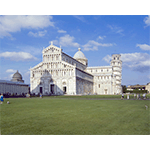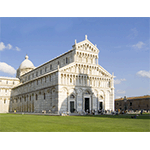Cathedral of Santa Maria
The construction of the cathedral of Pisa began in 1063 on a project by Buscheto. Consecrated in 1118, and restored following the tragic fire of 1595 and in the course of the 19th century, it houses masterpieces that make it one of the most famous and celebrated monuments: in addition to a rich sculptural decoration, worthy of note are the bronze door by Bonanno Pisano, the pulpit by Giovanni Pisano, Cimabue’s mosaic , and the pictorial cycle of the Tribune.
According to tradition, it was precisely inside the Cathedral around 1583 that, observing a lamp sway, the young Galileo Galilei was stimulated to undertake the road which was to lead him to discover the isochronism of pendulums. In his Racconto istorico della vita di Galileo (1654), loyal follower of Galileo, Vincenzo Viviani wrote: «Meanwhile, with the wisdom of his genius, he invented the very simple and regulated measuring of time by means of the pendulum, by no one observed till then, grasping the opportunity to observe it from the motion of a lamp, while he was one day in the Cathedral of Pisa».
Antonio Favaro demonstrated that the suspended lamp that still today is observed in the Cathedral was placed there after Galileo’s stay in Pisa. He therefore argued that the lamp referred to by Viviani had to be considered as a legend. More recently, however, it has been demonstrated that at the time of Galileo, there was another votive lamp suspended in the Cathedral, which is today found in the Monumental Cemetery of Pisa.
****************************
Texts by Graziano Magrini
English translation by Victor Beard
Last update 09/ott/2008





